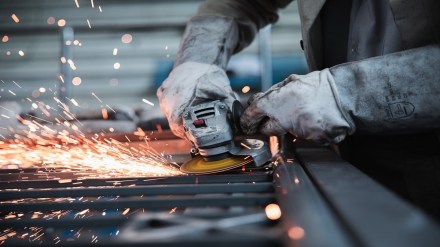India’s manufacturing activity fell to an eight-month low of 56.5 in September, in comparison to 57.5 in August, highlighting a robust improvement in the health of the sector that was nonetheless the weakest since January, data released by S&P Global on Tuesday showed. With manufacturing growth softening throughout the second fiscal quarter, the average PMI reading slipped to its lowest since the three months to December 2023, it said.
Pranjul Bhandari, Chief India Economist at HSBC, said, “Momentum in India’s manufacturing sector softened in September from the very strong growth in the summer months.”
The September data revealed a mild setback in manufacturing growth across India with rates of expansion in factory production and sales receded for the third straight month. Per the report by S&P Global, international orders rose at the slowest pace in a year-and-a half. However, despite this loss of growth momentum, net employment and quantities of purchases rose, while business confidence was broadly aligned with its long-run average. On the price front, there were moderate increases in input costs and selling charges.
While positive demand trends, successful advertising and favourable client interest featured as the main determinants of sales growth, the upturn, which was substantial but the slowest in 2024 so far, was reportedly curbed by fierce competition, the report said. Another factor that constrained total sales growth was a softer increase in new export orders. The rate of expansion was moderate and the least pronounced in a year-and-a-half.
“Output and new orders grew at a slower pace, and the deceleration in export demand growth was especially evident as the new export orders PMI was the lowest since March 2023. Input prices rose at a faster rate in September while factory gate price inflation eased, intensifying the compression on manufacturers’ margin. Weaker profit growth might have an impact on companies’ hiring demand, as the pace of employment growth slowed for a third month,” said Pranjul Bhandari.
Cost pressures, meanwhile, ticked higher in September, with panellists citing increased chemical, packaging, plastic and metal prices. In historical terms, the rate of inflation was mild, however.
September data highlighted another substantial increase in quantities of purchases among goods producers with the rise being supported by new business growth, positive client appetite and greater production requirements. Yet, input buying expanded at the slowest pace in the calendar year-to-date.
In terms of hiring, growth receded in September, reflecting a reduction in the number of part-time and temporary workers at some firms. Those that recruited extra staff cited projects in the pipeline. The combination of job creation and slower increases in new business meant that companies were able to stay on top of their workloads. Outstanding business volumes were unchanged in September, ending an 11-month sequence of accumulation.
Meanwhile, the HSBC report stated that inventory trends were mixed with the current sequence of falling stocks of finished goods that began more than seven years ago was stretched to September, while holdings of raw materials increased sharply again. The latter was supported by a further improvement in average lead times.
Going forward, around 23 per cent of Indian manufacturers forecast output growth in the year ahead, while the remaining firms predict no change. Hence, the overall level of business confidence fell to its lowest since April 2023.
